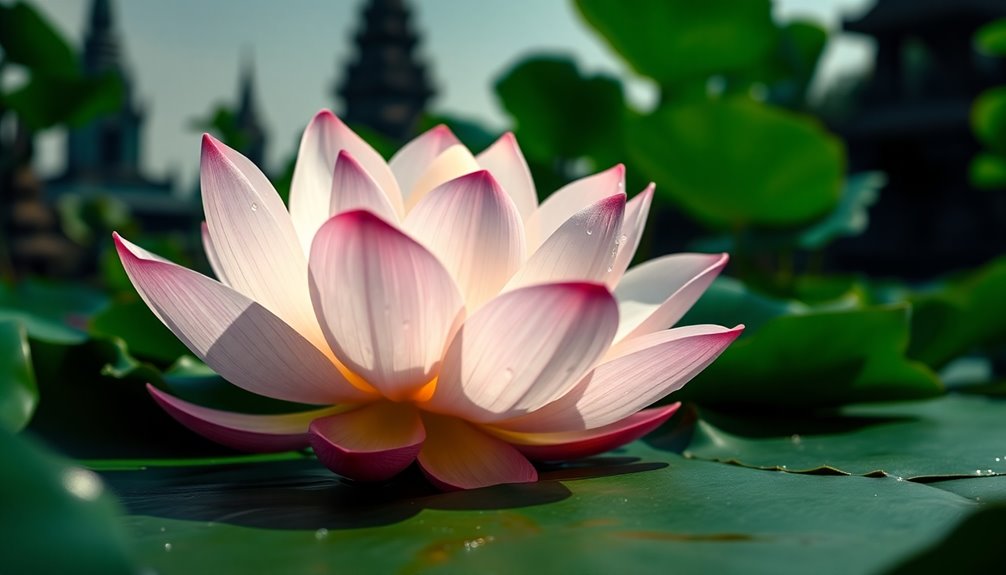The lotus flower is a beautiful symbol in Buddhism, representing purity and enlightenment. It grows in muddy waters yet rises above, showing that we can overcome challenges in life too! Different colors of the lotus carry special meanings, like the white lotus, which signifies mental purity, and the red lotus, representing love. Each stage of the lotus's growth, from a closed bud to a fully bloomed flower, reflects our journey in finding wisdom and compassion. This remarkable flower inspires us to cultivate our own spiritual paths. Discover more about the lotus's rich symbolism and its impact on spiritual journeys!
Key Takeaways
- The lotus flower symbolizes purity and enlightenment, illustrating the journey of spiritual growth rising from muddy waters.
- Different lotus colors represent various spiritual qualities, such as wisdom (blue), love (red), and spiritual perfection (white).
- The Lotus Sutra emphasizes that enlightenment is accessible to all beings, symbolizing interconnection and the potential for spiritual awakening.
- The growth stages of the lotus reflect spiritual development, from potential awareness to full enlightenment through overcoming challenges.
- Lotus imagery in art reinforces its symbolism, representing purity and the journey toward enlightenment across various cultures.
Significance of the Lotus Flower

In Buddhism, the lotus flower holds profound significance as a symbol of purity and enlightenment. You'll notice that the lotus symbolizes the journey of life. It grows in muddy waters but rises above the surface to bloom beautifully. This shows how, no matter how tough your circumstances are, you can achieve spiritual perfection.
Just like the lotus, you can overcome your struggles and reach new heights. The different stages of a lotus's growth—from a closed bud to a fully opened flower—represent your own spiritual journey. Each stage is a step toward understanding and realizing your potential.
In Buddhist art and stories, the lotus appears often, reminding everyone of its important message. For example, the white lotus stands for purity, while the pink lotus reflects the essence of the Buddha himself.
These colors highlight the many spiritual qualities in Buddhism.
The Lotus in Buddhist Teachings

The lotus flower is more than just a beautiful plant; it's a powerful symbol in Buddhist teachings that represents the potential for enlightenment. In Buddhism, the lotus is considered a sign of purity and spiritual awakening. It grows in muddy waters, yet rises above, untouched and stunning. This illustrates how you can overcome challenges and desires on your path to wisdom.
Here's a simple table to show what the lotus represents in different aspects of Buddhism:
| Aspect | Representation | Meaning |
|---|---|---|
| Spiritual Growth | Path to Enlightenment | Journey from ignorance to wisdom |
| Artistic Symbolism | Throne for the Buddha and Bodhisattvas | Sign of purity and spiritual accomplishment |
| Key Teachings | Lotus Sutra | Emphasizes compassion and interconnectedness |
Through these teachings, you see how the lotus represents different stages of growth and understanding. It encourages you to embrace your journey, reminding you that you can rise above life's muddy waters and bloom beautifully.
Stages of Lotus Growth

Let's explore the amazing stages of lotus growth!
The closed bud shows potential, just like you when you're starting your journey.
As it opens up, it represents the exciting path of learning, and when it fully blooms, it symbolizes reaching enlightenment, where everything becomes clear and beautiful!
Closed Bud: Potential Awakening
Symbolizing the potential for awakening, the closed bud of the lotus flower represents the initial stage of spiritual development. At this point, you might not fully realize your true nature. You're rooted in ignorance and attachment, but deep inside, you hold the potential for growth. This is an exciting time!
In Buddhist teachings, the closed bud shows that enlightenment is possible for everyone. No matter where you are on your journey, the potential for awakening lies within you, waiting to flourish.
Here's a quick look at the characteristics of the closed bud stage:
| Aspect | Description |
|---|---|
| State | Closed and hidden |
| Understanding | Limited awareness |
| Attachment | Rooted in desires |
| Potential | Growth and awakening |
| Transformation | Moving toward enlightenment |
As you reflect on this stage, remember that every individual has the capability to transform. Like the closed bud, you have the power to blossom into your fullest self. Embrace the journey ahead, as each step takes you closer to awakening!
Partly Open: Spiritual Journey
Growth characterizes the partly open lotus flower, reflecting your ongoing spiritual journey and the gradual process of awakening. This stage shows you moving beyond ordinary perception. You're beginning to understand the deeper meanings of life, and that's exciting!
In Buddhist teachings, the partly open lotus symbolizes an important phase. Here, you engage in practices that help develop wisdom and compassion. It's like a beautiful transformation where you start to see the world differently.
The partly open petals remind you that spiritual progress takes time. Patience and dedication are key!
As you journey along this path, you'll find that each step brings new insights. The imagery of the partly open lotus is often found in art and literature, inspiring you to embrace your own growth.
It highlights that everyone has the potential for change and enlightenment. This journey parallels the importance of clear communication during a breakup, as both require understanding and reflection to foster growth and healing.
Fully Bloomed: Enlightenment Achieved
Achieving enlightenment is like witnessing the fully bloomed lotus, a powerful representation of your spiritual journey's culmination. When you see the lotus in full bloom, it symbolizes the realization of your true nature. You've reached the ultimate goal in Buddhism! This stage shows how you've transcended suffering and found a state of perfect wisdom and compassion.
The growth of the lotus is truly inspiring. It starts as a closed bud, just like your spiritual journey, and then unfolds beautifully. This process illustrates how enlightenment is about awakening your inherent potential. You may have faced challenges, just like the lotus that blooms in muddy waters, but you've emerged with clarity and purity of mind through your spiritual practice.
In Buddhist art, the fully bloomed lotus often serves as a throne for important figures, highlighting its divine presence and spiritual authority.
When you think of the fully bloomed lotus, remember that it's not just a flower; it's a symbol of hope and achievement. You can celebrate your journey and look forward to your own blooming moment, where wisdom and compassion shine bright!
Color Symbolism of the Lotus
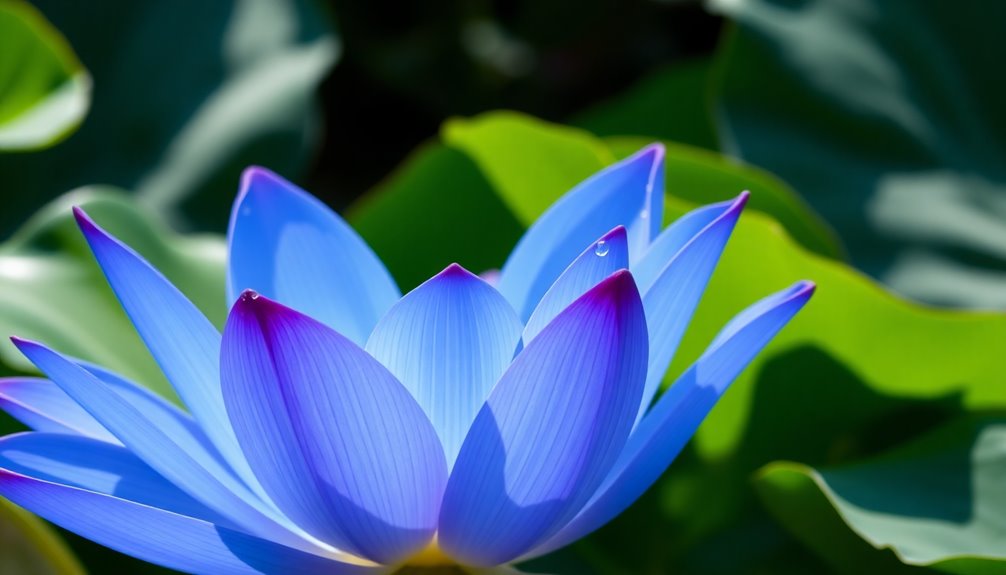
The lotus flower's colors each carry profound meanings in Buddhism, reflecting various aspects of the spiritual journey. Each color you see represents something special.
For instance, the white lotus symbolizes mental purity and spiritual perfection. This beautiful flower represents the ultimate goal of enlightenment in Buddhism.
Here are some more meanings behind different lotus colors:
- Red Lotus: This one embodies love and compassion, blooming fully to show the heart's original state.
- Blue Lotus: Shown partially opened, it signifies wisdom, knowledge, and the start of a spiritual journey.
- Pink Lotus: Regarded as the supreme lotus, it represents the essence of the Buddha and purity.
In addition, the purple lotus symbolizes rare mystical experiences, while the red lotus reminds you of the importance of compassion.
Each color adds a layer to the lotus's beauty and meaning. So next time you see a lotus, remember that these vibrant colors tell a story about spiritual growth and transformation.
Isn't that exciting? The lotus truly represents the journey towards enlightenment in many beautiful ways!
The Lotus Sutra Explained
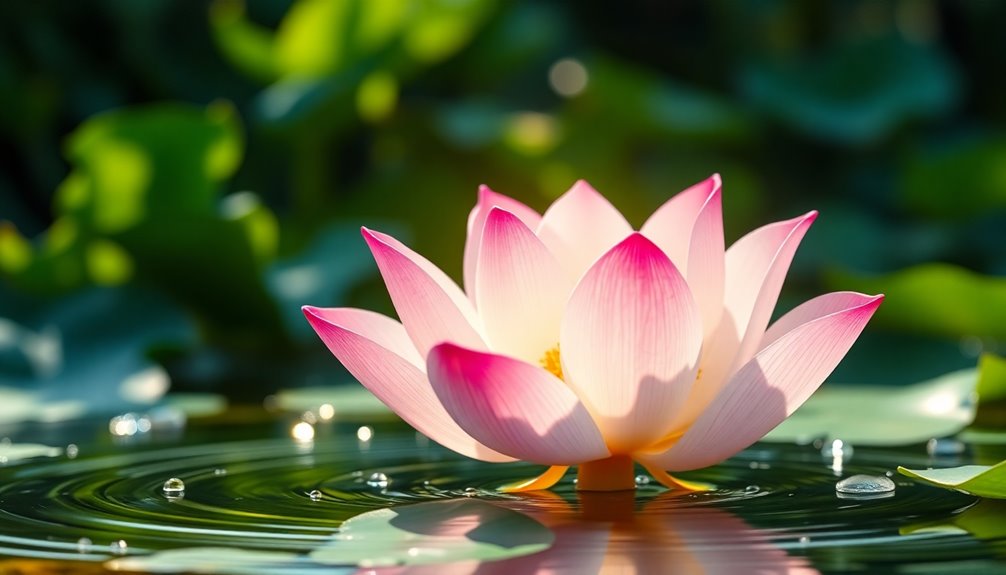
One of the most important texts in Mahayana Buddhism, the Lotus Sutra reveals that enlightenment is within reach for everyone, much like a lotus flower blooming from muddy waters. This beautiful message shows that no matter where you start in life, you can grow and reach your potential.
The Lotus Sutra teaches that all beings are connected and have the ability to achieve Buddhahood. Just as lotus flowers rise from murky water, you too can rise above difficulties and discover your true nature. The Sutra emphasizes compassion and selfless service, urging you to help others on their paths toward enlightenment.
Throughout the Lotus Sutra, you'll find engaging stories and metaphors, using the lotus flower as a powerful symbol of spiritual awakening. These stories help explain important ideas about reality, cause and effect, and how to live a meaningful life.
The Lotus Sutra has greatly influenced many Buddhist schools, especially in shaping Pure Land practices and the bodhisattva ideal. By exploring this remarkable text, you can gain insight into your own spiritual journey and the beauty of the lotus flower.
Lotus Imagery in Buddhist Art
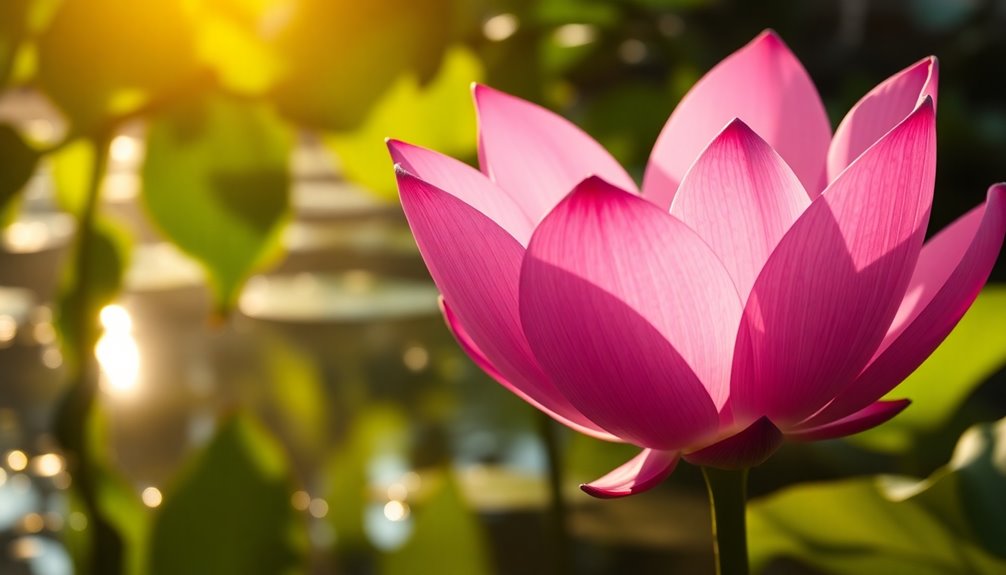
When you look at Buddhist art, you'll notice lots of beautiful lotus images that tell stories about the journey to enlightenment.
These flowers appear in stunning mandalas and sculptures, highlighting their special meaning in Buddhism.
Each lotus color, like the pure white or the warm red, adds even more to the message of compassion and spiritual growth.
Depictions of Enlightenment Journey
In Buddhist art, lotus imagery vividly illustrates the stages of the enlightenment journey, inviting viewers to contemplate their own spiritual paths. The lotus is the symbol of growth, rising from muddy waters to bloom in beauty. This journey can be seen in various forms of art, revealing the path to enlightenment.
- Closed buds represent potential, showing that everyone has the ability to grow.
- Partly opened flowers indicate the awakening process, reminding you that growth takes time and patience.
- Fully bloomed lotuses symbolize the attainment of enlightenment, celebrating a state of purity and wisdom.
Many important figures in Buddhism, like the Buddha and bodhisattvas, are often depicted seated on lotus thrones. This placement emphasizes their enlightened status and connection to spiritual awakening.
The vivid colors of lotus flowers used in art also carry special meanings. For example, the red lotus stands for love and compassion, while the white lotus signifies purity.
These images invite you to contemplate your own journey, encouraging you to rise above challenges and bloom beautifully, just like the lotus. Embracing these symbols can deepen your understanding of your spiritual path!
Lotus in Mandalas
Lotus imagery plays a significant role in mandalas, reinforcing the themes of spiritual awakening and purity. When you look at a mandala, you might notice the lotus at its center, symbolizing the journey from muddy waters to the bright bloom above. This beautiful flower represents the potential for every being to achieve enlightenment.
In mandalas, you can find lotus flowers in different colors, each with its own special meaning. Here's a quick look at some of them:
| Lotus Color | Symbolism |
|---|---|
| White | Purity |
| Red | Love and Compassion |
| Pink | Spiritual Awakening |
| Blue | Wisdom |
| Purple | Mystical Transformation |
The stages of the lotus bloom also illustrate the path from ignorance to enlightenment. As the lotus rises, it teaches us about growth and the beauty of awakening spiritually. So when you see a lotus in a mandala, remember, it's not just a flower. It's a powerful reminder of the journey toward a clearer mind and a brighter heart!
Symbolism in Sculptures
Through intricate sculptures, the lotus flower emerges as a powerful symbol in Buddhist art, often depicted in connection with significant figures like the Buddha and bodhisattvas.
You'll notice these figures seated or standing on lotus thrones, which represent their purity and enlightenment. The lotus grows from muddy waters, reminding us of spiritual growth and the beauty that can arise from challenging circumstances.
Here are a few key meanings behind lotus imagery in sculptures:
- Stages of Growth: The closed bud symbolizes potential, while the fully bloomed flower represents enlightenment.
- Color Significance: Different colored lotuses convey unique messages—the pink lotus represents the Buddha, while the white lotus symbolizes purity and spiritual perfection.
- Interconnectedness: The lotus reminds us that all beings share a journey toward enlightenment, achievable through perseverance and faith.
When you see lotus sculptures, think of the journey of spiritual growth, rising above worldly attachments to reach a state of peace.
This delightful symbol invites everyone to explore their own potential and embrace the path to enlightenment!
Cultural Interpretations of the Lotus
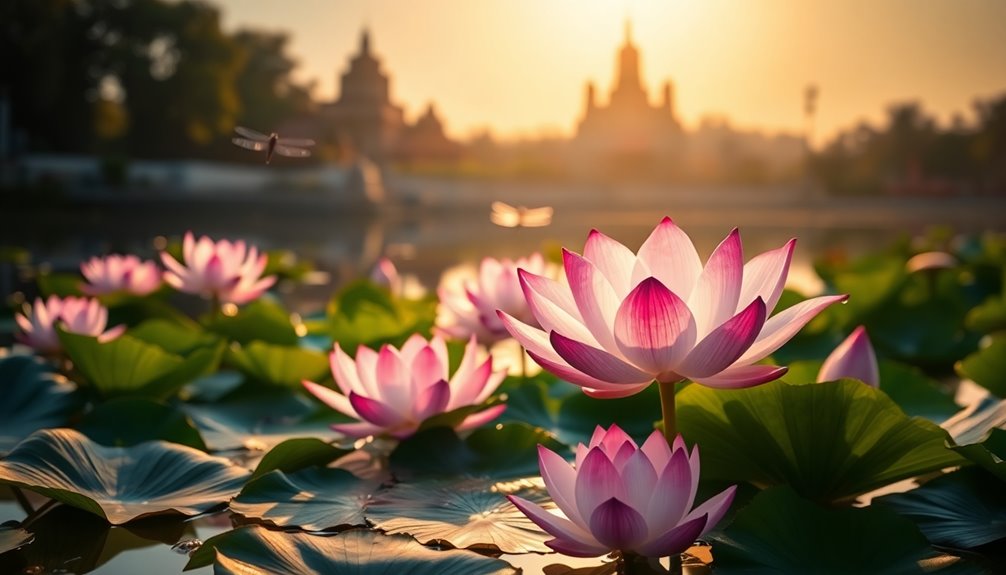
Cultures around the world have embraced the lotus flower for its profound symbolism, often drawing connections between its growth and human resilience. This beautiful flower blooms in muddy waters, reminding us that we can rise above challenges.
Here's a quick look at how different cultures interpret the lotus:
| Culture | Symbolism | Color Significance |
|---|---|---|
| Egyptian | Rebirth and the sun | N/A |
| Chinese | Harmony and moral integrity | Blue: Wisdom, Red: Love |
| Buddhist art | Purity and enlightenment | White: Mental purity |
| Indian | Spiritual awakening | Pink: Divine love |
| Japanese | Transience and beauty | N/A |
In Buddhist art, the lotus is often depicted beautifully, showcasing its significance in spirituality. Each color of the lotus holds unique meanings, adding depth to its symbolism.
Whether it's about love, wisdom, or purity, the lotus inspires hope and strength. It teaches us that, like the flower, we can flourish even in tough situations. So, the next time you see a lotus, remember its rich cultural meanings and the beauty it represents!
The Role of Chanting in Buddhism

Chanting plays an essential role in Buddhism, connecting practitioners to their spiritual roots and enhancing their understanding of key teachings. When you chant "Nam-myoho-renge-kyo," you're diving deep into the wisdom of the Lotus Sutra. This practice isn't just about words; it's about transformation!
Here's what chanting can do for you:
- Connects you to the lotus flower: The lotus symbolizes enlightenment, reminding you of your own potential for growth.
- Cultivates positive qualities: As you chant, you develop courage and compassion, which are super important on your spiritual journey.
- Fosters immediate transformation: You can realize your Buddhahood right now, bringing positive change to your life.
Daisaku Ikeda beautifully explains that chanting deepens your understanding of the Lotus Sutra. It also inspires you to be resilient and seek happiness, even when challenges arise.
Lotus Symbolism in Other Religions
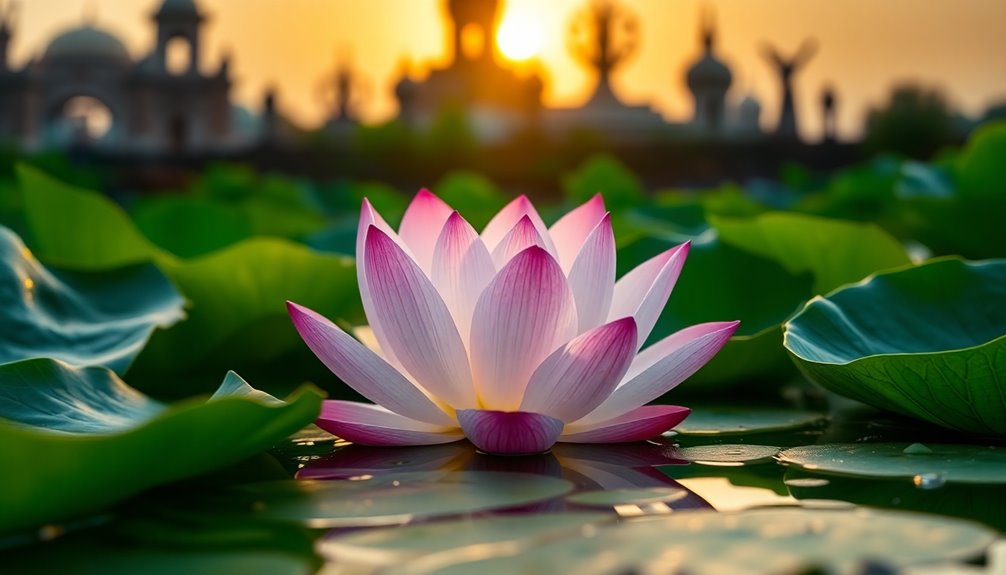
The lotus flower's symbolism extends far beyond Buddhism, resonating deeply in various religions and cultures around the world. In Hinduism, the lotus represents divine beauty and spiritual awakening. It often grows in muddy waters, yet it rises above, showing purity and detachment from materialism. You might see it depicted as the seat of deities like Lakshmi and Vishnu.
Ancient Egyptians also cherished the lotus. They believed it represented rebirth and the sun, symbolizing resurrection and the afterlife. You can find beautiful lotus images in their art and mythology!
In China, the lotus represents harmony and moral integrity. It embodies the ideal of achieving purity amidst challenges and is often featured in poetry and art, reminding us of resilience.
Did you know that different colors of lotus flowers have special meanings too? The blue lotus signifies victory of spirit over intellect, while the pink lotus is seen as the supreme flower, embodying enlightenment.
Lastly, in Jainism, the lotus represents renunciation and the journey of the soul toward liberation. It emphasizes purity and the potential for spiritual growth.
Isn't it exciting how the lotus grows and represents so much across different religions?
Practical Applications of Lotus Symbolism

Now that we've explored the lotus's meaning, let's look at how you can use its symbolism in your life!
You can grow lotus plants in your garden, creating a peaceful spot that inspires calm and connection.
Plus, adding lotus imagery to your art or meditation can help you focus on your personal growth and remind you to approach life with an open heart.
Personal Spiritual Growth
Incorporating the lotus flower's symbolism into your personal spiritual journey can be transformative. Just like the lotus rises from muddy waters, you too can overcome challenges and grow spiritually.
It's a beautiful reminder that you can achieve enlightenment, no matter where you start.
Here are some practical ways to embrace the lotus flower in your life:
- Practice Mindfulness: Take time each day to meditate. This helps you find inner peace, just like the lotus represents purity.
- Reflect on Growth: Think of your life as stages of a lotus flower. Each small step you take is important for your personal spiritual growth.
- Decorate with Intent: Surround yourself with lotus-inspired art or symbols. They can inspire you to reflect on your spiritual path and remind you of your potential.
Environmental Aesthetics Enhancement
Embracing the lotus flower in your outdoor spaces can greatly enhance their aesthetic appeal while also grounding them in deeper spiritual meanings. Imagine a lovely water garden filled with these beautiful flowers. Their large, striking blooms not only catch the eye but also symbolize spiritual purity and resilience.
The lotus thrives in muddy waters, reminding us that we can find beauty and strength even in tough situations. When you add lotus flowers to your ponds, you create a serene environment perfect for meditation and reflection. This aligns beautifully with Buddhist principles of mindfulness and tranquility.
Plus, these flowers attract wildlife, encouraging biodiversity and creating a joyful ecosystem in your garden. The daily blooming of the lotus serves as a metaphor for your own spiritual journey. It inspires you to nurture your path toward enlightenment.
Cultural Art Integration
The lotus flower's rich symbolism permeates various forms of cultural art, offering a profound connection to Buddhist teachings. You'll notice the lotus flower symbolizes purity and spiritual awakening in many artworks. It's a beautiful reminder of our journey toward enlightenment.
Artists often use lotus imagery in different ways, like:
- Paintings and sculptures: These often show the lotus blooming, representing the beauty of overcoming struggles.
- Textiles: You'll find lotus designs on robes and ceremonial garments, reflecting the spiritual themes of Buddhist practice.
- Architecture: Temples showcase lotus motifs, symbolizing the sacredness of the space and the growth of those who enter.
In contemporary art, the lotus flower's symbolism shines through, conveying messages of resilience and transformation.
You might even find it in meditation spaces or gardens, enhancing your spiritual environment. This encourages tranquility and fosters a deeper connection to the teachings of Buddhism.
Frequently Asked Questions
Why Are Lotus Flowers Important to Buddhism?
Lotus flowers are super important in Buddhism because they show how beautiful things can grow from muddy waters.
When you see a lotus, you're reminded that everyone can rise above challenges and find peace. The different colors of lotus flowers also mean special qualities, like love and purity.
Plus, they're often used in art to represent wise figures, making them a lovely symbol of spiritual growth and enlightenment for all!
What Does the Buddha Hand Holding a Lotus Flower Mean?
When you see the Buddha holding a lotus flower, it's like spotting a superhero with a magical power!
This gesture represents purity and the journey to enlightenment. The lotus grows in muddy waters but stays clean, showing that you can rise above challenges.
It reminds you that, no matter how tough life gets, you can find beauty and wisdom within.
The lotus in the Buddha's hand inspires you to grow, learn, and shine brightly!
What Does the Flower Symbol Mean in Buddhism?
In Buddhism, flowers symbolize beauty and the potential for spiritual growth. They remind you of life's fleeting nature, encouraging you to cherish each moment.
Various flowers have different meanings. For example, the lotus represents purity and enlightenment as it grows from muddy waters. This shows that you can rise above challenges.
When you see a flower, think about your journey and the beauty that comes from overcoming difficulties. Embrace that growth!
What Is the Significance of the Lotus Flower?
Imagine a flower that grows beautifully, even from the mud! The lotus flower is significant because it represents purity and enlightenment. It teaches you that just like it rises above the muddy waters, you can overcome challenges and find inner peace.
Each stage of the lotus—from bud to bloom—shows your journey toward understanding and growth. Plus, different colors, like white and red, symbolize various qualities such as love and compassion. Isn't that inspiring?
Conclusion
So, the lotus flower is more than just a pretty plant; it's a powerful symbol in Buddhism! Just like the lotus rises from muddy waters to bloom beautifully, we can grow and shine despite our challenges. Each color of the lotus tells a unique story, and its journey inspires us to embrace our own paths. By understanding its meaning, you can carry a piece of this wisdom with you, blooming brightly in your own life.

